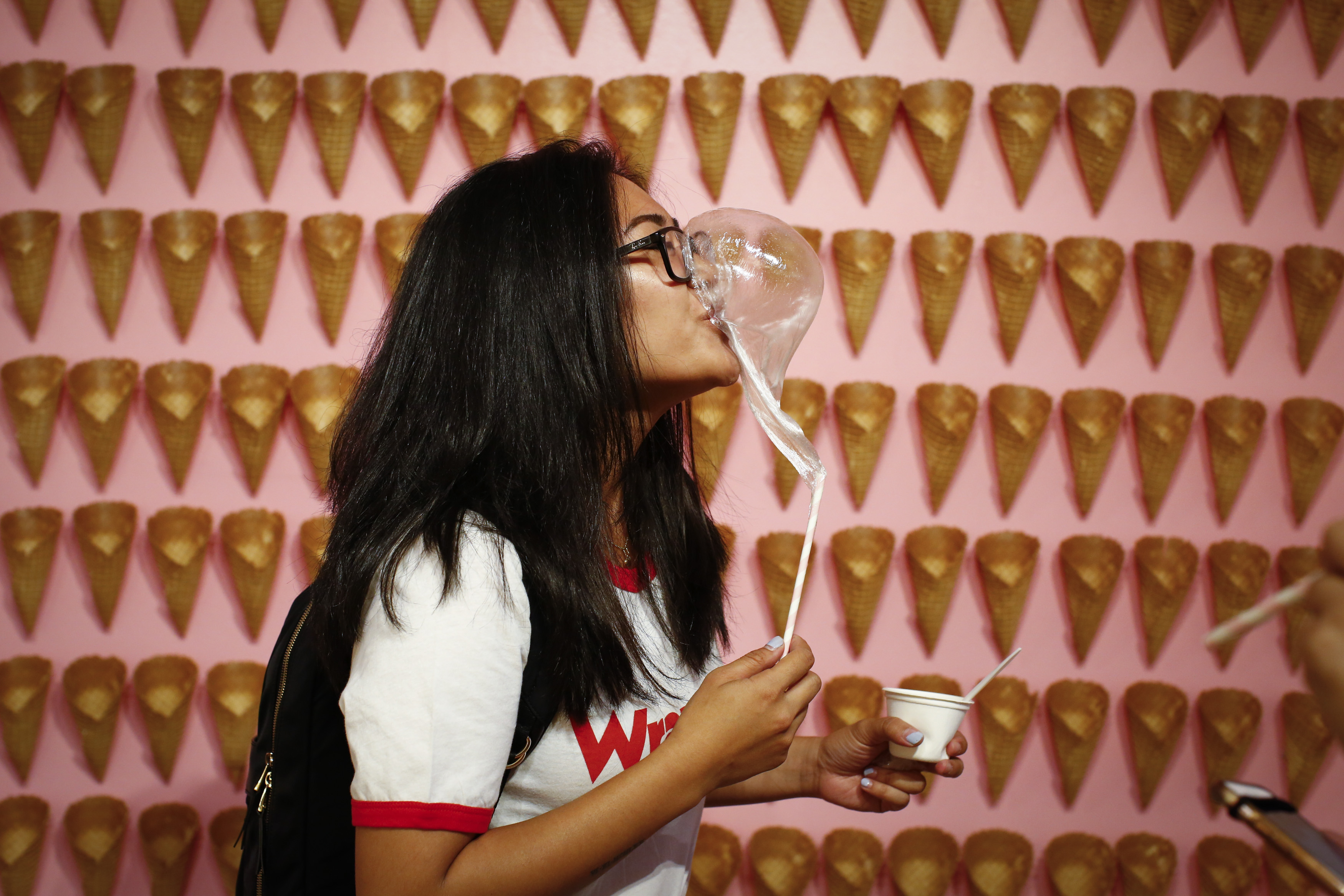I went to the Museum of Ice Cream. Here's what I learned.
We need more museums!


In the middle of an industrial section of downtown Los Angeles, on the fringes of Skid Row and in the shadow of graffiti-covered warehouses, sits a bubblegum pink building. It's the last place you'd expect to find the Museum of Ice Cream, yet there it is, a fantastically saccharine shrine to everyone's favorite frozen treat, where mint grows in chocolate soil, the wallpaper is scratch-and-sniff and smells like bananas, and you're encouraged to wade through an indoor pool filled with nearly 10 million multicolored plastic sprinkles.
It's a pop-up museum, and once its stint in Los Angeles is over, they'll pack everything up — including all those fake sprinkles from what is clearly the museum's most-Instagramed room — and go to the next stop in San Francisco.
On a recent sweltering summer day, I spent about an hour at the Museum of Ice Cream, and while I had a super fun time — where else can you relax on a swing shaped like a Neapolitan ice cream sandwich? — I did leave feeling like the Museum of Ice Cream was playing fast and loose with the word "museum."
The Week
Escape your echo chamber. Get the facts behind the news, plus analysis from multiple perspectives.

Sign up for The Week's Free Newsletters
From our morning news briefing to a weekly Good News Newsletter, get the best of The Week delivered directly to your inbox.
From our morning news briefing to a weekly Good News Newsletter, get the best of The Week delivered directly to your inbox.
The art installations were cute and whimsical (think giant gummy bears, plastic rainbows, and giant melting popsicles) and it was nice to cool off with various ice cream samples in different rooms. But this wasn't really a museum as much as it was a giant photo op and chance for you to go wild Snapchatting everything. Calling it an "homage to ice cream" would be a much more accurate description. Because as far as museums go, it was missing the essential educational elements that others have (although I did learn that a pre-pre-pre-White House Barack Obama worked at a Baskin-Robbins — file that one away just in case you're ever on Jeopardy!).
Could it be, though, that this is the future of museums? With the explosion of social media, more people are obsessed with getting the perfect photo of an object to post online, rather than gaining an understanding of who made it and why. Attention spans seem shorter, and as fads come and go, so too could temporary museums, their doors only open as long as there's interest in what's inside. As a supplement to well-curated permanent museums, having pop-ups dot the landscape — even if they're intellectually slight — might not be a bad idea.
The Santa Cruz Museum of Art and History thinks this is something worth pursuing, and has an entire website dedicated to instructing people on how to put together their own temporary exhibits. It starts with picking a theme and a venue, then inviting people to come down with their personal items to put on display. The museum suggests keeping the pop-ups going for just a day, and they can be held anywhere, from a coffee shop to a library to a laundromat. The goal, the museum says, is to "focus on bringing people together in conversation through stories, art, and objects. They can happen anytime, anywhere, and with any community."
That's one way of doing it, and a model similar to what the Museum of Ice Cream offers is another. Unlike the volunteer-only pop-ups, this one has a budget — although not anything exorbitant — and instead of having Picassos and Van Goghs up on the walls like a well-established museum, there are smaller pieces and installations from up-and-coming artists, plus interactive exhibits. To make this more like a museum in the truest sense of the word, though, there needs to be some educational aspects. There could be a guided tour with information on the artists that downloads to smartphones, perhaps, or even a meet and greet, where the artists answer questions from visitors.
A free daily email with the biggest news stories of the day – and the best features from TheWeek.com
I'll go out of my way to see a great museum, from the quirky ones to the traditional. I enjoy meandering through the galleries at my own pace, soaking in the details of centuries-old oil paintings and listening to the footsteps of my fellow visitors bounce off the walls as they walk through the marble hallways of the Getty Center. I love trying to count all of the tiles on the Endeavour at the California Science Center and listening to kids gasp when they see the giant space shuttle for the first time.
We need museums to collect and protect objects that are culturally and historically important, and I don't think it's possible to have too many. Not every city can have a Metropolitan Museum of Art, a LACMA, a National Gallery, or a Louvre, so maybe we ought to broaden our idea of what a museum is and can be. Pop-ups don't always look or feel like your traditional conception of a museum, but they can still be fun, educational, and community-building — and remove many of the longstanding barriers to entry for new museums. And you never know which one might be truly great.
Catherine Garcia has worked as a senior writer at The Week since 2014. Her writing and reporting have appeared in Entertainment Weekly, The New York Times, Wirecutter, NBC News and "The Book of Jezebel," among others. She's a graduate of the University of Redlands and the Columbia University Graduate School of Journalism.
-
 Heavenly spectacle in the wilds of Canada
Heavenly spectacle in the wilds of CanadaThe Week Recommends ‘Mind-bending’ outpost for spotting animals – and the northern lights
-
 Facial recognition: a revolution in policing
Facial recognition: a revolution in policingTalking Point All 43 police forces in England and Wales are set to be granted access, with those against calling for increasing safeguards on the technology
-
 Codeword: December 14, 2025
Codeword: December 14, 2025The daily codeword puzzle from The Week
